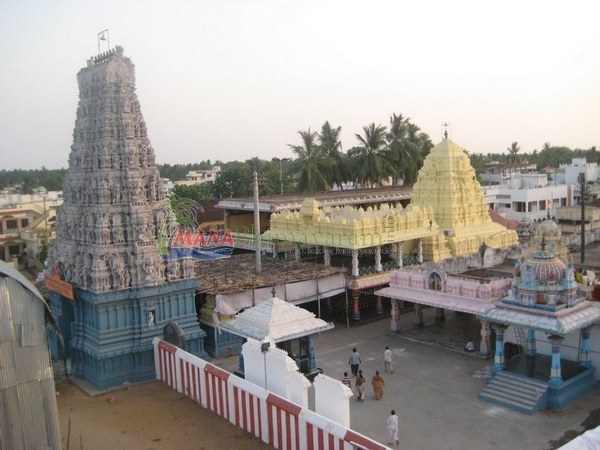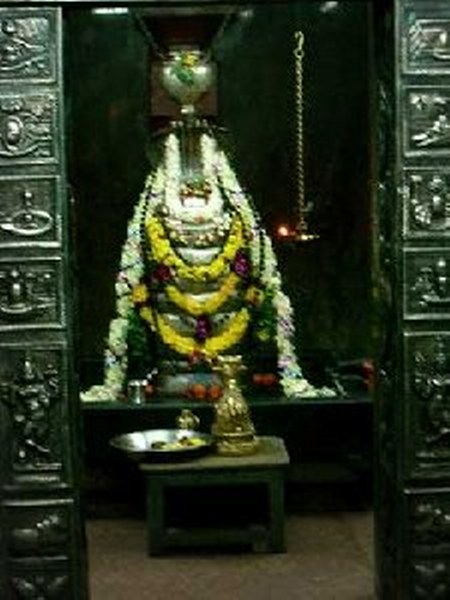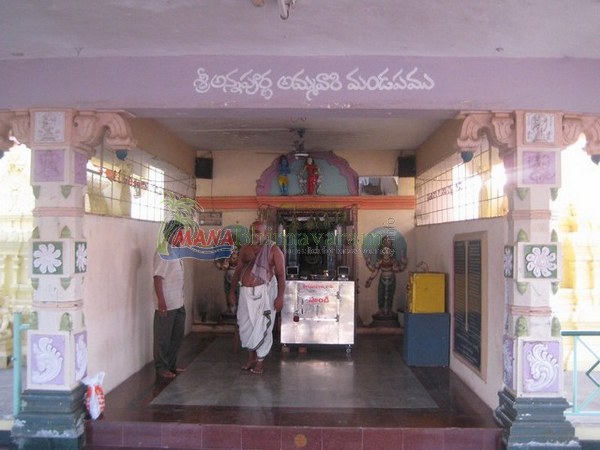 Sri Someswara Janardhana Swamy Devastanam is located on the banks of River Godavari at Gunupidi near Bhimavaram of West Godavari district. It is one of the famous Pancharama Kshetras in Andhra Pradesh. The presiding deity is Lord Shiva in the form of Sri Someswara Janardhana Swamy with His consort is Sri Rajarajeswari Ammavaru.
Sri Someswara Janardhana Swamy Devastanam is located on the banks of River Godavari at Gunupidi near Bhimavaram of West Godavari district. It is one of the famous Pancharama Kshetras in Andhra Pradesh. The presiding deity is Lord Shiva in the form of Sri Someswara Janardhana Swamy with His consort is Sri Rajarajeswari Ammavaru.
History of the Temple
The temple was built by King Chalukya Bheema during 4th century. Shivalinga was installed by Moon God and hence the temple named as Somarama, as Sanskrit word soma means Chandra (God Moon). It is believed that the color of the Shivalinga changes according to the Lunar-rays. In a month the statue brightens to white for 15 days gradually day by day and turns into black for another 15 days.
Goddess Annapurna Temple is located above the Garbha gruha which is a unique construction of this temple. This resembles the fact that Lord Siva holds the Goddess Ganga on His head. To the South of the Garbha gruha,  Goddess Adilakshmi can be seen. To the East side of this temple, there is a Pushkarini pond which is also called Chandrakundam. Inside the temple there are other deities; Lord Anjaneya Swamy, God Kumara Swamy, Navagraha, Sun God and Lord Ganesha.
Goddess Adilakshmi can be seen. To the East side of this temple, there is a Pushkarini pond which is also called Chandrakundam. Inside the temple there are other deities; Lord Anjaneya Swamy, God Kumara Swamy, Navagraha, Sun God and Lord Ganesha.
There are two Shivalingas in the temple namely Koteswara Swamy Linga and Someswara Swamy Linga. Koteswara Swamy Linga was installed by Lord Indra and Someswara Swamy Linga by Lord Soma (Moon God) to get rid of curse. Sri Siddi Janardhana Swamy, Goddess Sridevi and Goddess Bhoodevi installed by Kasyapa Maharshi are the Kshetra Palakas of this temple. There is a separate shrine for Goddess Raja Rajeswari Ammvaru. The other deities in the temple are Lord Anjaneya, Lord Kalabhairava and Navagrahas.
The Holy River is very famous for its sacred water. It was brought by Gowtham Maharshi. As per Gowthami Mahatyam, if any person takes a bath in this Holy Water will be purified from all kinds of sins. Koteswara Lingam is a Yoga Lingam and Someswara Lingam is a Bhoga Lingam.
Legend of the Temple
Sri Koteswara Lingam
Once Lord Indra fell fond of Ahalya wife of Gauthama Maharshi. He played a play and diverted Gauthama Maharshi. In his disguise form he embraced Ahalya. When Gauthama Maharshi came back, Ahalya realized that she was cheated by someone. Lord Indra changed His form to cat and tried to escape. Gautham Maharshi got angry and cursed Lord Indra with life disease and Ahalya to change into a rock.
Ahalya and Lord Indra later pleaded Gauthama Maharshi for shaapa vimochana. Gauthama Maharshi asked Ahalya to wait till Lord Rama touches her with His feet. He told Lord Indra to take bath in Gauthami River and perform pooja to Lord Shiva. Lord Indra installed Shivalinga named Koteswara Linga and performed pooja to get rid of His sin.
Sri Someswara Lingam
Lord Soma was fond of Tara, wife of His guru. Due to His mistake Lord Soma lost chaya (glow) in his face. He realized his mistake and prayed Lord Vishnu for shaapa vimochana. Lord Vishnu was pleased and told him to take bath in Gauthami River and install Shivalinga and perform pooja to get rid of sin. Lord Chandra took bath and installed Shivalinga with Goddess Rajarajeswari. As Lord Soma installed the Shivalinga and relieved from the sin it is named as Chaya Someswara Swamy Lingam.
 Another unique feature here, is that the temple of Goddess Annapurna was built on top of the Shiva temple, something that cannot be seen anywhere in the country. Surprisingly, the Goddess has the sacred thread around her neck and a baby near her feet. Here Lord Shiva is known as Sri Someswara Janardhana Swamy here. The consort of Lord Someswara is Sri Rajarajeswari Ammavaru.
Another unique feature here, is that the temple of Goddess Annapurna was built on top of the Shiva temple, something that cannot be seen anywhere in the country. Surprisingly, the Goddess has the sacred thread around her neck and a baby near her feet. Here Lord Shiva is known as Sri Someswara Janardhana Swamy here. The consort of Lord Someswara is Sri Rajarajeswari Ammavaru.
To the South of the Garbha Gruham, Goddess Adilakshmi can be seen and wedding hall at ground and first floor are constructed. Marriages are conducted both in the new hall and also in Goddess Annapurna mantapam.
To the East side of this temple, there is a Pushkarini pond which is also called Soma Gundam. Inside the temple, Lord Anjaneya Swamy, God Kumara Swamy, Navagraha, Sun God, Lord Ganesha can also be seen. In front of the main entrance, 15-foot pillar is constructed.
The Temple Timings
- 5.00 am to 11.00 am
- 4.00 pm to 8.00 pm
Poojas and Festivals
- Maha Shivaratri and Devinavarathris are the main festivals celebrated grandly at this temple. Rudrabhishakam and bilvarchana are performed in the early hours from 4am. They offer prayers by reading Vishnu Sahasra Nama and Akasadeepam is lighted throughout all month.
- In the center of the city, the temple of Rain Goddess (Varala Thalli) Maullamma is situated. The statue is 8ft hight. Each Fridays special poojas are performed at this temple. Yearly grand celeberations are held during Maha Shivarathri festival.